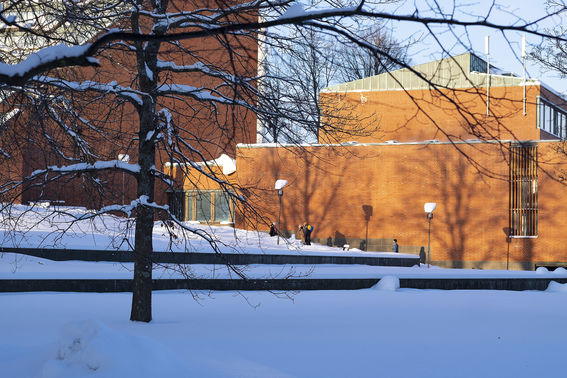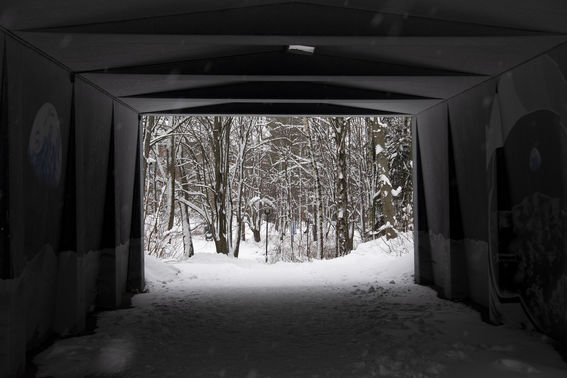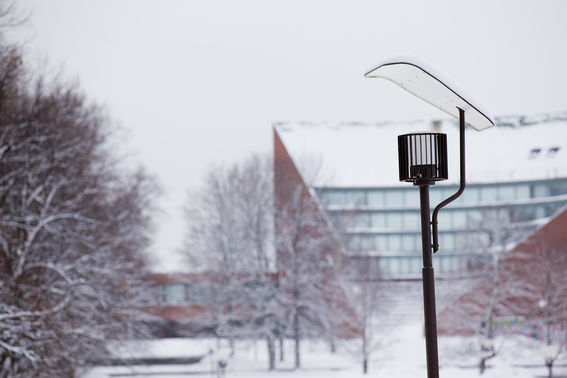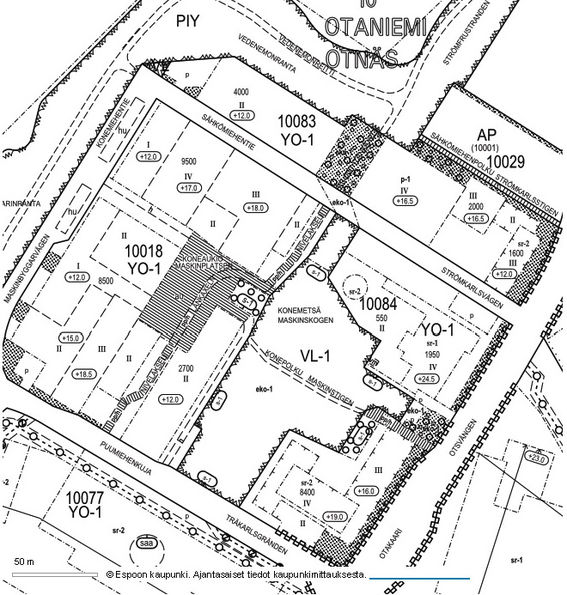The origin of the name Otaniemi is a mystery

'The village name Otnäs is ambiguous and open to various interpretations,' says Dr. Saulo Kepsu, researcher in onomastics, in the book Kylä-Espoo – Espoon vanha asutusnimistö ja kylämaisema (in Finnish; Village Espoo – Names of Espoo's old settlements and village landscape) (2008).
The meaning of names fascinates people. It is natural for people to name not only persons, animals and different things, but also places. In addition, residents also translate or change names to better suit their own language.
The book Village Espoo lists possible sources for Ot-, the first part of the name Otaniemi: ohto, or bear, the Finnish first name Uoti (Olaf or Olli) or, based on the Bronze Age burial mounds, the name could have been Hautaniemi, from which it would have evolved into Houtnäs, Outnäs and ultimately Otnäs over time.
'Sometimes you stop and wonder why a certain place is called by a specific name. When we live in a certain place, we learn the local names while living there, not needing a separate learning process for that. Through names, we also share cultural-historical heritage. For as long as people have used languages, so long there have been names,' says Terhi Ainiala, Finnish-language University Lecturer at the University of Helsinki.
Otnäs, the Swedish name of Otaniemi, may be a combination of a Finnish name given to the place earlier and a geographical word. The region's current Finnish name Otaniemi, on the other hand, is a Finnicized version of the Swedish name.

The influence of residents and the community on the place names
'Otnäs is an old Finnish village. In the absence of information on the names of local houses, it remains open where the residents and later Swedish newcomers originally came from,' Kepsu continues.
We will probably never fully find out the origin of the name Otaniemi. Perhaps the original meaning of the name would no longer suit the modern-day world anyway.
'People change and the language lives, so the names evolve with them. People name things to make them easier to talk about. We have a natural need to distinguish between things we consider relevant, and place names help us figure out our environment and orientate ourselves in it. Names are necessary tools for identifying different places and other locations, for describing what we consider most important about them. Thus, the names also tell us how others have perceived the area,' says Ainiala.
Although the background of the name Otaniemi remains open, some places in the area have been named after Otaniemi. The oldest road in the area is probably Otaniementie. The name of the road also serves as a guide for those visiting the area: here you can find Otaniemi.

Student humour and tributes to people
'In the place names, we use as much old, established and generally used names as possible. Of course, they are not enough when an area evolves from a rural landscape to a city,' says Kaija Mallat, who works as a name planner at the City of Espoo.
Kaija Mallat and her colleague Sami Suviranta say that the name may simply describe a location (there is a Chapel Park by the chapel), but there are also three other ways to name places.
Compound names are related to some other place name (Otakaari to the name Otaniemi), theme names (Tekniikantie, Ekonominaukio, referring to technology and degree in economics) are related to the thematic topic of the area, and the commemorative names (Alvarinaukio) are given in memory of a person who has influenced the area.
In addition to the thematic vocabulary related to the world of higher education, Otaniemi has another speciality. In the campus area, there is playful variation in the end parts of the names: tie – road, taival – trail, polku – path, kuja – alley, aukio – square, solmu – knot, ranta – shore, puisto – park, kallio – rock, piha – yard. No ‘streets’ (katu) are found in Otaniemi.
The Governing Body of Otaniemi, appointed by the Ministry of Trade and Industry, managed the area's matters in 1948–1994. It has named many places in Otaniemi.
'Several place names reflect the traditions of technology students. For example, Jämeräntaival refers to an engineer with a thick beard, and Servin Maijan tie and mökki (Maija Servi’s road and cottage) are also familiar from the technology student culture,' Suviranta says.

Alvar Aalto Park or Alvarinaukio square?
Other feature bringing colour to the distinctive place names in Otaniemi, in addition to the technology student and higher education culture, are the tributes to those who have influenced the way the area has found its form. The winning proposal for the local detailed plan was originally made by Aino and Alvar Aalto, so today we can find the Alvar Aalto Park, Alvarinaukio and Ainonaukio squares in the area.
If the name Alvar Aalto Park sounds unfamiliar to you, there is a reason for that. Over time, the name Alvar Aalto Park had fallen off the campus maps, and it was replaced in both maps and speech by Alvarinaukio, which in fact refers specifically to the square in front of the shopping centre A Blanc. Actually, the larger, more park-like area between the Harald Herlin Learning Centre, the Undergraduate Centre and the Aalto University Student Union office is called Alvar Aalto Park.
'Of course, in spoken language it is quite all right to also use the name Alvarinaukio for the entity formed by those two adjacent areas if the community is used to it,' Suviranta says.
On maps, however, the names Alvar Aalto Park and Alvarinaukio must be marked correctly, so Aalto University's campus maps will also be updated accordingly in the near future.

Based on a community proposal, the intention is also to mark the name Elissanpiha between the Undergraduate Centre and Rakentajanaukio square as a tribute to Elissa Aalto. According to the name planners, there is no suitable place for the name in the current local detailed plan map, but it can be added to the address map of Espoo.
The developing campus area produces new names
Place names are rarely changed, so it is a significant event when this happens. It is important for emergency vehicle routing in particular that the address system functions logically.
The name planners say that the need to change names often arises, for example, when a road is permanently cut off, forming a new road.
Otaniementie was cut off due to the A Block shopping centre, Väre building and School of Business building, and the construction of the Jokeri Light Rail. This is how Maarintie came to Otaniemi.
'We usually try to keep the addresses unchanged, as residents are naturally often attached to the names. A change of address always causes a lot of trouble for the residents. Espoo made a major change in the place names in the 1970s when Espoo became a city and it was discovered that there were several places with the same name inside the new city,' says Mallat.
However, according to the name planners, new names will be coming to Otaniemi too. After the completion of the Aalto Works block in 2024, you will be able to stroll in Konemetsä (Machine Forest), with such adjacent places as Koneaukio (Machine Square), Konepolku (Machine Path) and the pedestrian path Nivelakseli (Cardan Shaft). The change in the local detailed plan regarding these names was approved in autumn 2021.
|
Further information
Name planning in City of Espoo Planning in Tapiola, Espoo (Otaniemi is part of Greater Tapiola)
Interviews
Terhi Ainiala, University of Helsinki
Kaija Mallat, City of Espoo
Sami Suviranta, City of Espoo
Other sources
Espoon eteläosien historiallisen ajan kylänpaikkojen yleiskaavainventointi 2005, Museovirasto (in Finnish; Master plan inventory of the southern parts of Espoo in historical times).
Härö, Erkki 1991, s.166: Espoon rakennuskulttuuri ja kulttuurimaisema (in Finnish; Espoo building culture and cultural landscape). Espoon kaupunginmuseo. Hangon kirjapaino.
Toim. Mallat, Kaija; Suviranta, Sami ja Luoto, Reima T. A. 2008, s. 101-103: Kylä-Espoo – Espoon vanha asutusnimistö ja kylämaisema (in Finnish; Village Espoo – Names of Espoo's old settlements and village landscape). Espoon kaupunki.
Read more news

Textile Chemistry Group Meeting Held
The Annual Meeting of The Textile Chemistry Group held on Thursday, December 11, uniting researchers, doctoral candidates, master’s students, and interns to present their advances in sustainable textile technologies.
Meet Patrick Fleming, assistant professor of structural and architectural engineering
Fleming believes making the most of existing buildings is key to reaching a sustainable future.
Call for Applications: Aalto Creatives Pre-incubator Programme Spring 2026
Join the Aalto Creatives afterwork and info session on 20.1.2026 to find out more about the open call and meet the Aalto Creatives team. At this event, alums from the pre-incubator tell about their entrepreneurial journeys and share their experiences from participating in the AC programme.






